Heading
- Basic structure of waves
- Degree and Labeling Table
- fractal structure
- Motive and Modified Waves
- impulse
- diagonal
- zigzag
- flat
- triangle
1.Basic structure of waves
The movement to be propelled by 5 waves and the movement to be corrected by 3 waves will be interwoven.

Propulsion: A move in the same direction as the major trend direction, resulting in a 5-wave move.
Correction: A move in the opposite direction of the major trend direction or a sideways break, essentially a 3-wave move.
Five-wave move: A five-wave move in an upward direction consists of three up moves with two down moves in between. A 5-wave move in a downtrend is the opposite.
3-wave move: A 3-wave move in a downtrend consists of two down moves with an up move in between. An upward 3-wave move is the opposite.
Counting or labeling: Counting waves by adding a number or letter to each wave. The symbol is placed at the end of the wave. Motive waves should be numbered and corrective waves should be alphabetic symbols.
2.Degree and Labeling Table
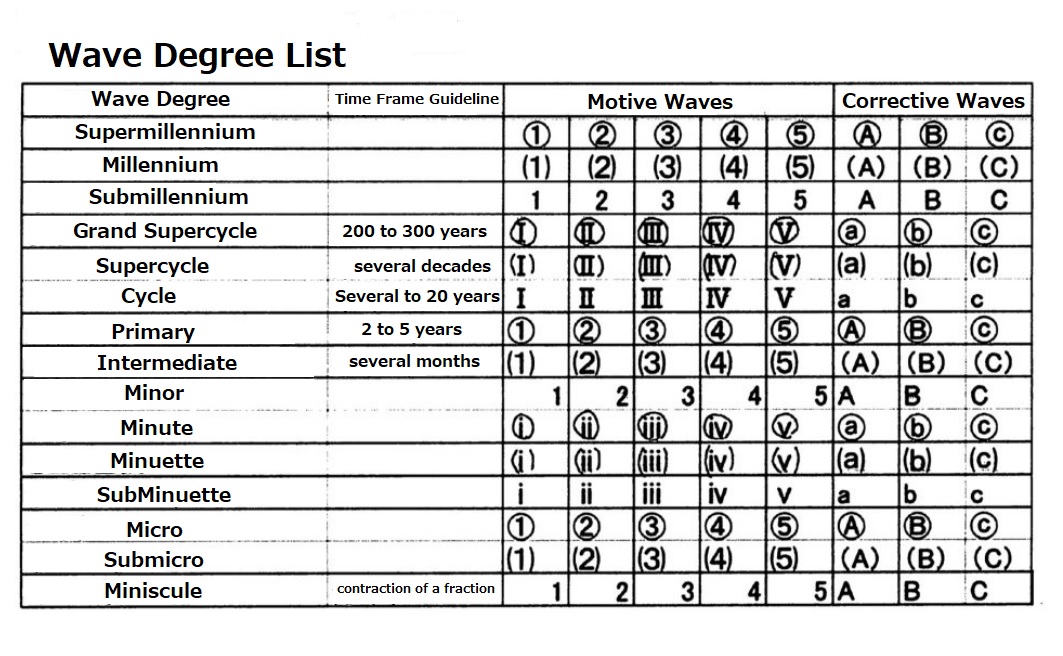
3.fractal structure
Stock prices have a fractal structure that consists of multiple action waves and reaction waves.
*Action wave: a wave that moves in the same direction as a larger wave
Reaction wave: A wave that corrects in the opposite direction of the larger wave
Note that, although confusing, motive wave and modified wave are slightly different concepts from action wave and reaction wave. Motive and corrective waves are discussed below.
Wave hierarchy (degree): The five waves from wave 1 to wave 5 form a larger wave, which are called the (1) wave, (3) wave, (4) wave, etc. The waves from wave 1 to wave 4 are called the (4) wave, (5) wave, etc. The five waves from wave 1 to wave 5 form a larger wave, which is called the (1) wave, (3) wave, (4) wave, (5) wave, and (6) wave. In this way, stock price waves are made up of multiple layers. This hierarchy of waves is also called a degree.
Sub-order wave: A wave that is one level smaller than the others that make up a single wave.
Fractal structure: A structure in which smaller structures come together to form larger structures, larger structures come together to form larger structures, and so on. And the structures of both small and large structures are similar in shape. Stock prices have this very fractal structure, and almost the same pattern is repeated whether viewed on a minute-by-minute basis or on a monthly basis.
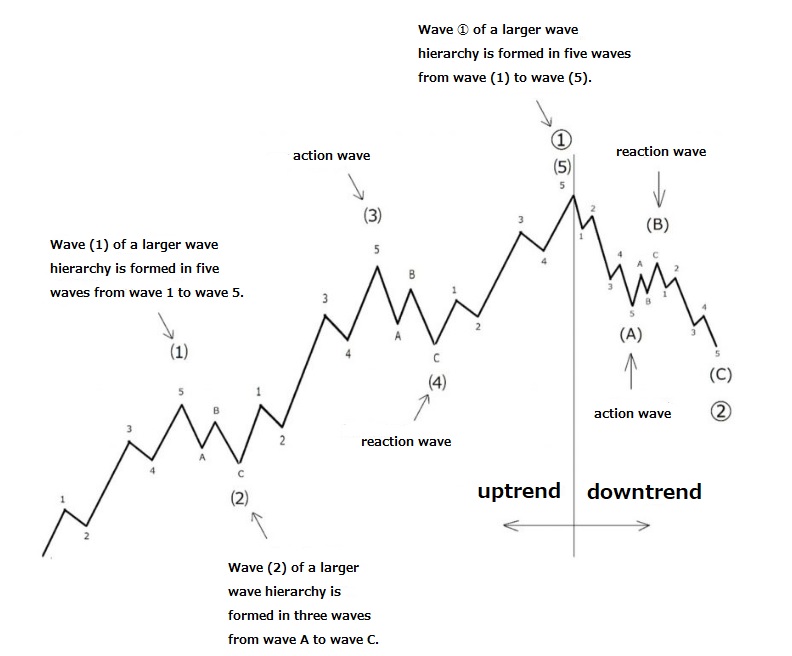
Waves 1 to 5 come together to form waves (⑴, ⑶, and ⑸), and waves A to C come together to form waves (⑵ and ⑷). Waves (⑴ to ⑸) gather to form wave (①). Waves (1) to (5) come together to form wave (A), and waves (A) to (C) come together to form wave (2). This process is repeated to form waves of larger and larger levels.
Wave (3), indicated by the arrow in the figure, is an action wave because it has the same direction as the larger wave (1), and wave (4) is a reaction wave because it has the opposite direction as the larger wave (1).
Wave (A), indicated by the arrow in the figure, is an action wave because it is in the same direction as wave (2), which is larger in size, and wave (B) is a reaction wave because it is in the opposite direction of wave (2), which is larger in size.
4.Motive and Corrective Wave
Stock price movement patterns can be summarized into five basic waveforms, which can be broadly classified into motive waves and corrective waves.
Motive wave: A five-wave waveform that appears as an action wave.
Corrective wave: A three-wave waveform that appears mainly as a reaction wave, but also appears as an action wave in some cases.
5.Basic waveform (1) Impulse
This is a motive wave with a 5-3-5-3-5 5-wave configuration, and the waves do not overlap with each other, resulting in a clean motive waveform. The 3 waves are not the smallest of the 3 action waves: the 1, 3, and 5 waves of the secondary waves.
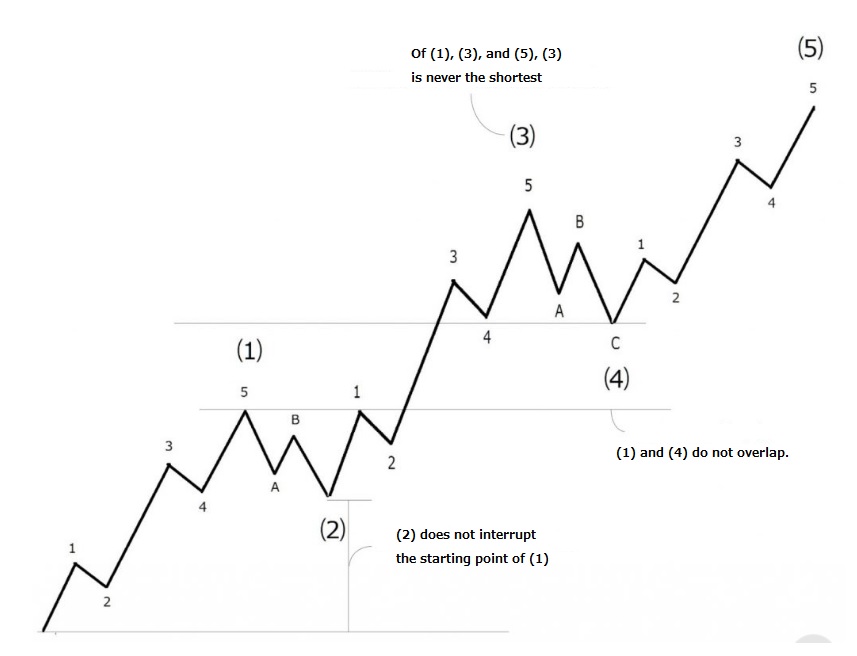
6.Basic waveform (2) Diagonal
A Motive wave with a 5-wave configuration of 3-3-3-3-3 or 5-3-5-3-5 The waveform is basically an overlapping wave, with the wave motion gradually contracting and projecting in either vertical or horizontal direction. It appears as the first or last secondary wave in a larger waveform.
3-3-3-3-3 Type Diagonal
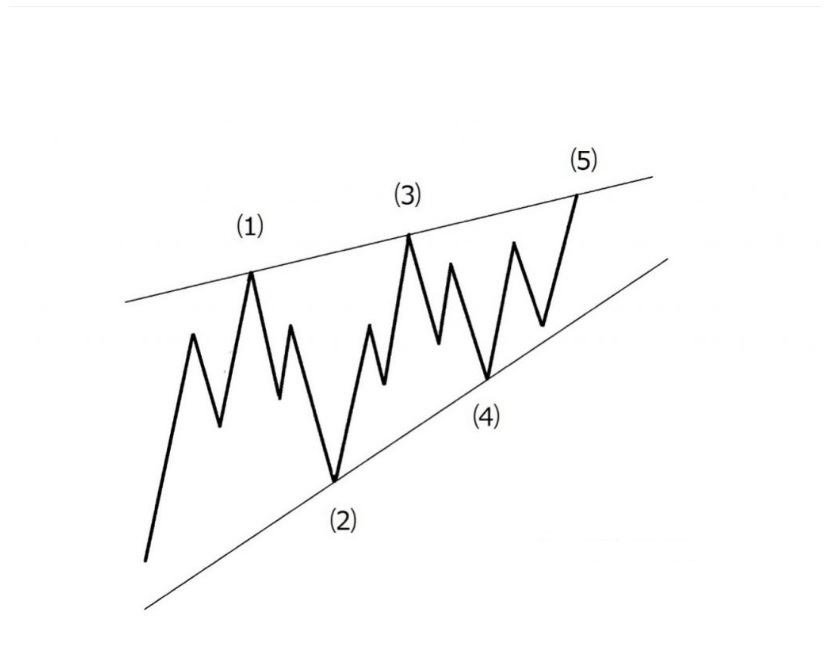
5-3-5-3-5 Type Diagonal
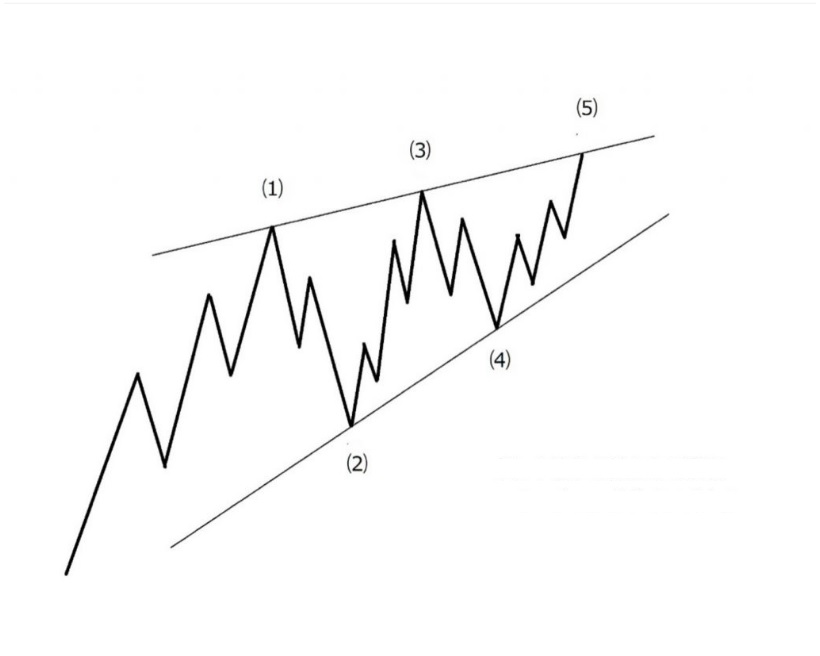
7.Basic waveform (3) Zigzag
Corrective wave of a 5-3-5 3-wave structure. Basically, the (B) wave endpoint exceeds the (A) wave endpoint and the (C) wave endpoint exceeds the (B) wave endpoint.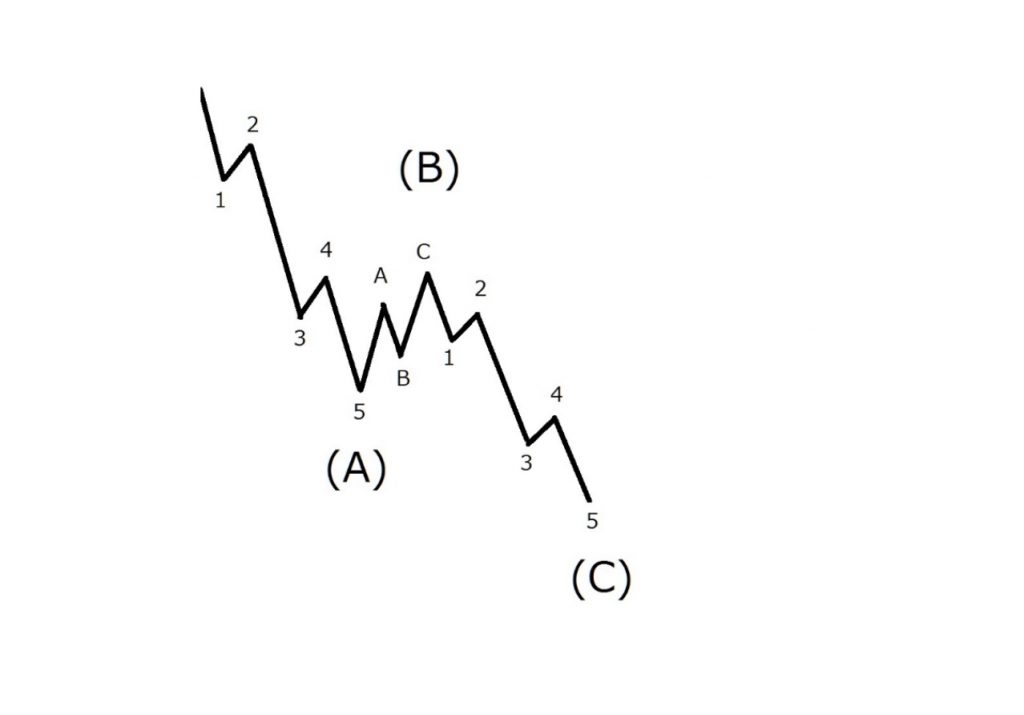
8.Basic waveform (4) Flat
Corrective wave with a 3-3-5 configuration.
The (B) wave endpoint returns to near the (A) wave start point and the (C) wave endpoint returns to near the (B) wave endpoint, which is called a regular flat. However, extended flats, in which the (B) wave end point exceeds the (A) wave start point and the (C) wave end point exceeds the (B) wave start point, appear more frequently. Flats with a huge (C) wave also appear occasionally.
regular flat
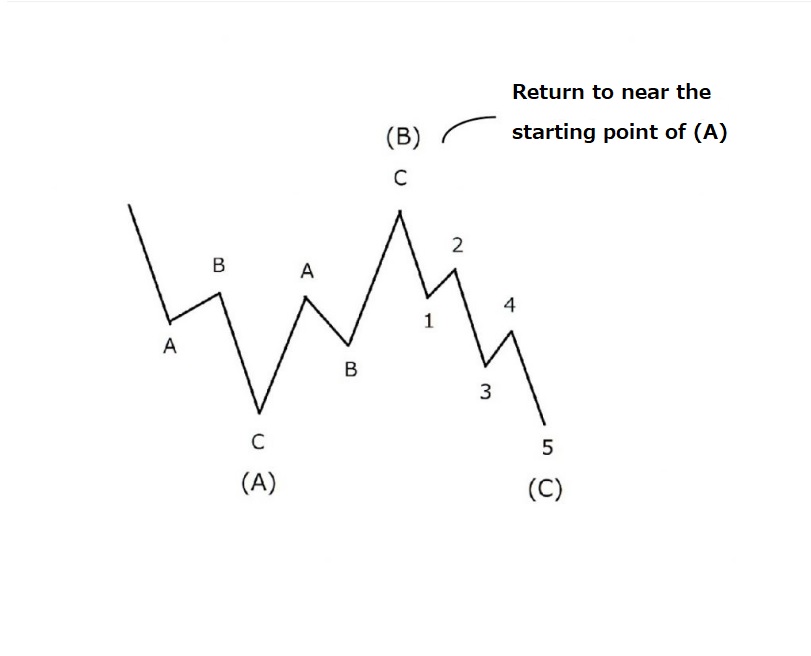
Enlarged flat
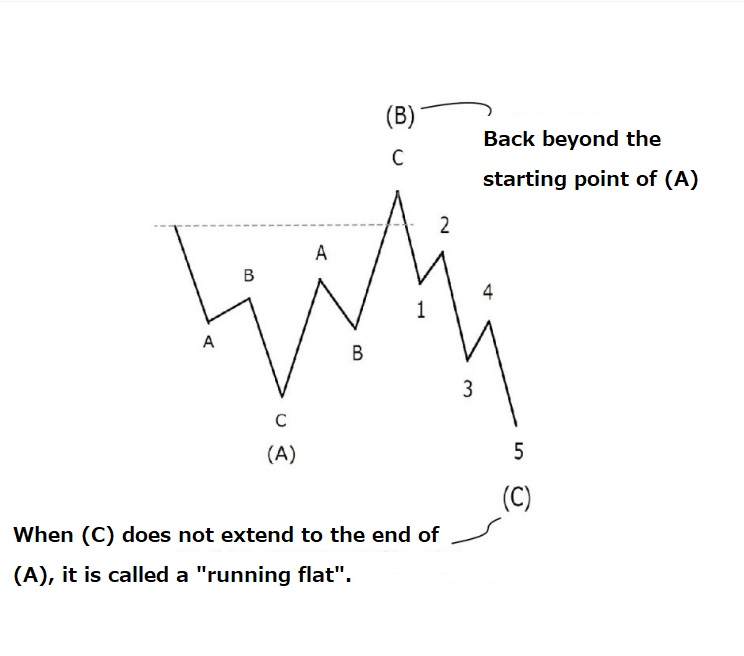
C wave huge type flat
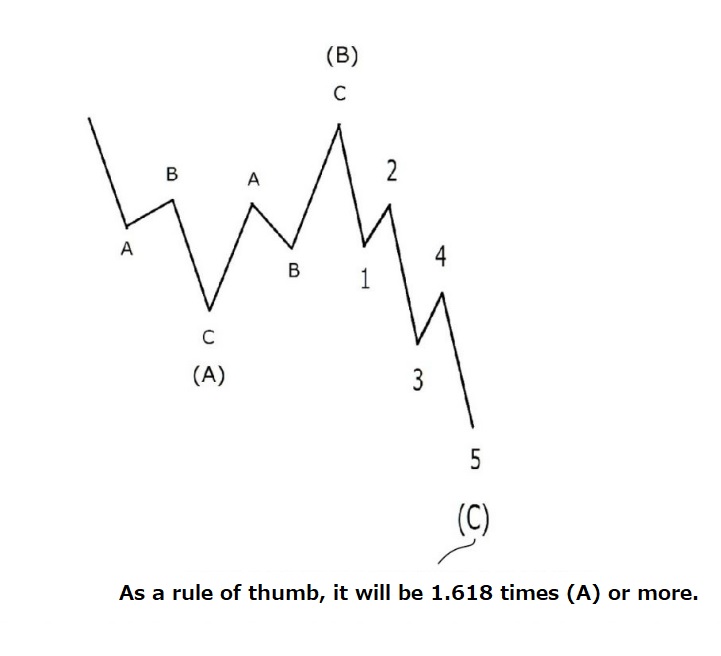
9.Basic waveform (5) Triangle
A corrective wave with a 5-wave configuration of 3-3-3-3-3.
Note that although it is a 5-wave structure, it is a corrective wave.
A waveform in which the corrective waves are horizontally linked and gradually contracting.
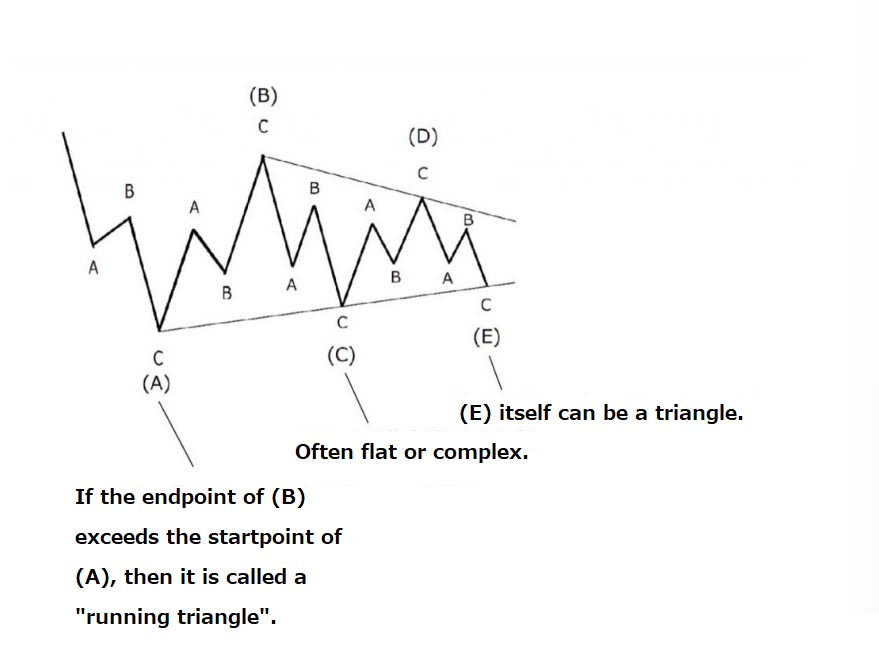
*Motive wave and modified wave are only classification names for waveforms. On the other hand, action wave and reaction wave are classifications of waves based on the direction of a larger wave motion. Many commentaries confuse the two, but this is incorrect.
*When the following explanation says 5-3-5-3-5-3-5, 5 means the secondary wave of a 5-wave structure and 3 means the secondary wave of a 3-wave structure, meaning that they are linked together.
*3 also includes triangles.
